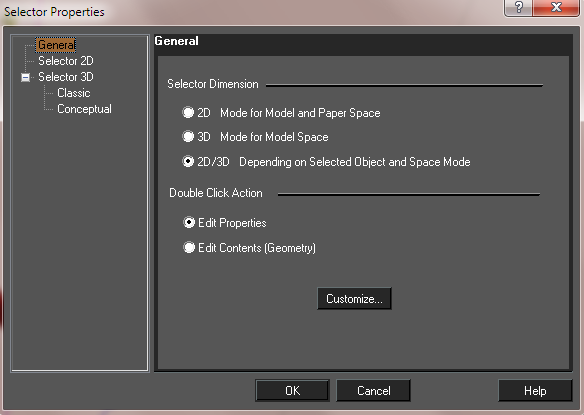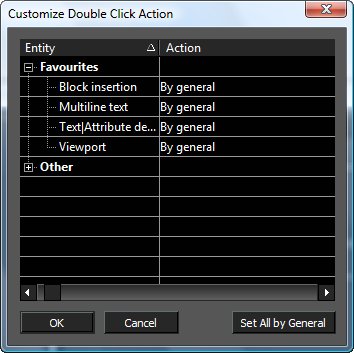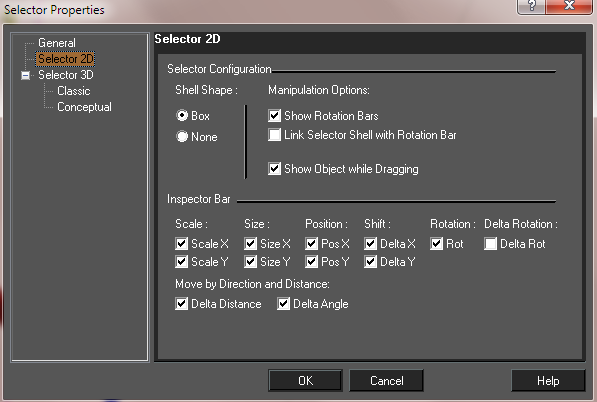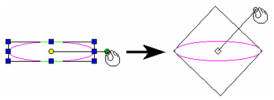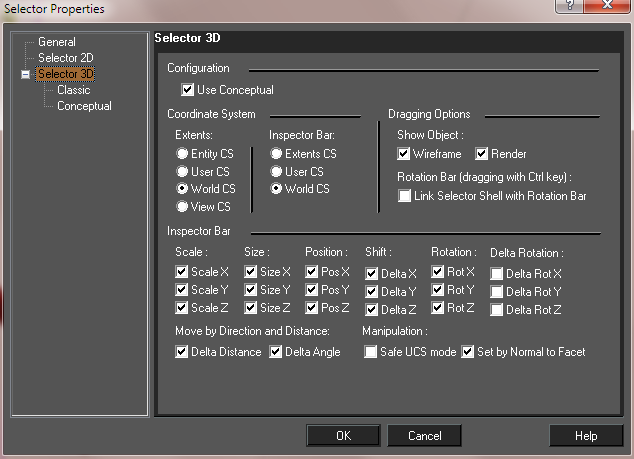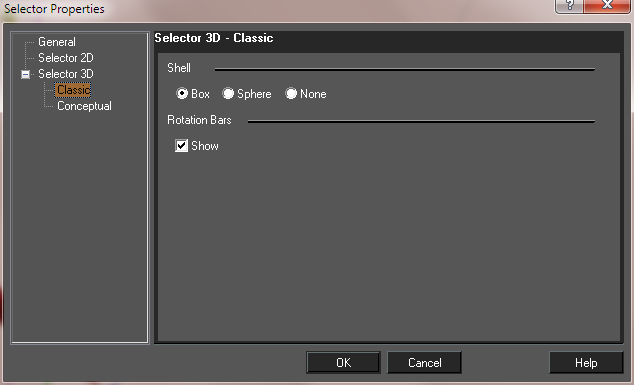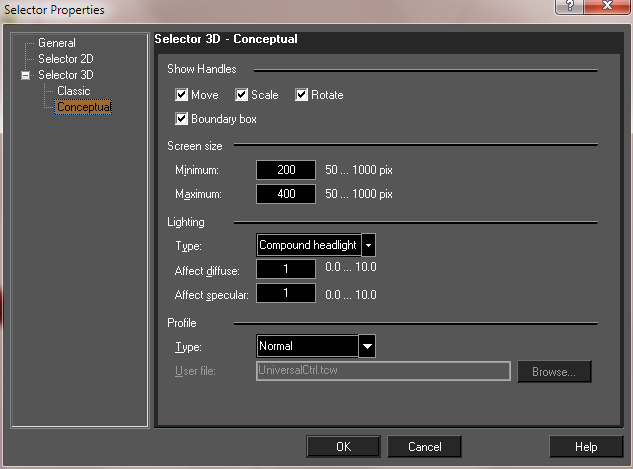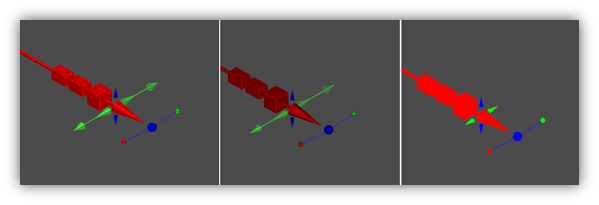2D - 3D Selector
of the 2D Selector can be set in the Selector Properties window. This can be opened by right-clicking anywhere while in Select mode, and selecting Selector 2D Properties from the local menu. (If the 3D Selector is active, the local menu item will be Selector 3D Properties.)
You can also click the icon on the Inspector Bar to open the Selector Properties.
While working, you can easily switch between 2D and 3D Selector Mode, without having to open the Selector Properties window.
Simply click the Toggle 2D/3D* icon on the Inspector Bar.
General
Controls how 2D and 3D objects are selected, and what transformation fields appear in the Inspector Bar.
2D Mode for Model and Paper Space: Treats all objects as if they are 2D, and only uses the 2D selection rectangle. The Inspector Bar contains transformation fields in X and Y only.
3D Mode for Model Space: Treats all objects as if they are 3D, and only uses the 3D selection box. The Inspector Bar contains transformation fields in X, Y, and Z.
2D/3D Depending on Selected Object and Space Mode: Treats objects differently; 2D objects are treated as 2D objects and 3D objects are treated as 3D objects.
Edit Properties: If this option is set double clicking on any object with the selector will open it Properties dialog.
Edit Content (Geometry): If this option is set double clicking on any object with the selector will set the object for editing. For most objects the will be the equivalent of activating the edit tool. For text double clicking will allow you to edit the text content.
Customize: Allows you to specify how double clicking will act for each class of objects.
Selector 2D
Options for 2D selection and fields in the Inspector Bar.
Shell Shape: Select None to make the selector shell (bounding rectangle) invisible. The options are:
- Box
- None
Manipulation Options
Show Rotation Bars: If unchecked, the rotation bar is not shown and is not accessible.
Link Selector Shell with Rotation Bar: If checked, when you press Ctrl and move the rotation handle, the selector shape will change accordingly.
Link Selector Shell not checked
Link Selector Shell checked
Show Object while Dragging: Displays the selected objects dynamically as they are transformed. If not checked, only the selection shell is visible.
Inspector Bar: Controls the 2D transformation fields that appear on the Inspector Bar. See Inspector Bar.
Note: The 2D Selector always moves the UCS (workplane) to the selection.
Selector 3D
Options for 3D selection, containing additional options for selection boxes and Inspector Bar fields. Many of these parameters are the same as for the Selector 2D page.
Configuration
Use Conceptual: Activates the Conceptual Selector (3D). When unchecked the Classic Selector
Coordinate System
CS Stands for COORDINATE SYSTEM
Extents CS: Sets the coordinate system (workplane) used by the selector shell. Because these settings work in tandem with other settings, their performance can become complex. Careful study of the Extents CS and Coordinate system parameters will help you understand this powerful tool.
Entity CS: Selector shell CS equals the CS of the selected objects.
User CS: Selector shell CS equals the CS of the current workplane.
World CS: Selector shell CS equals the world CS.
View CS: Selector shell CS equals the CS of the plane of the current view.
Inspector Bar: Sets the coordinate system (workplane) used by the Inspector bar. Because these settings work in tandem with other settings, their performance can become complex.
Entity CS: Inspector bar CS equals the CS of the selected objects.
User CS: Inspector bar CS equals the CS of the current workplane (UCS).
World CS: Inspector bar CS equals the world CS.
Dragging Options
Show Object: Displays the selected objects dynamically as they are transformed. If not checked, only the selection shell is visible. Two options are available which allow you to activate showing object for Wireframe, or Render, or both.
Rotation Bar (dragging with Ctrl key): If unchecked, the rotation bar is not shown and is not accessible.
Link Selector Shell with Rotation Bar: If checked, when you press Ctrl and move the rotation handle, the selector shape will change accordingly.
Inspector Bar
Sets the fields that appear in the Inspector Bar (see Inspector Bar.)
Scale and Size: X, Y, and Z fields.
Position: Current location.
Shift: Change in position.
Rotation: Rotation from position relative to the Extents CS.
Delta Rotation: Change in rotation from the current position.
Move by direction and Distance: Delta Distance and Delta Angle work in conjunction.
Delta Distance: the distance an objects is moved along the specified Delta Angle
Delta Angle: the angle along which an objects is moved the specified Delta Distance
There are only four possible scenarios where the user changes the value in either one or both of these fields, and then presses Enter. This is similar, in some ways, to drawing a line segment by length and angle.
Like the other Delta fields, once the user presses Enter and the changes have been made the fields will revert to a value of 0 (zero).
The Use Cases are as follows:
#1
Delta Angle Field Changed, Delta Distance Field Changed
Result
Everything that is selected moves the specified Distance at the specified Angle. Example: Delta Distance (16mm) at 36.8 degrees. The selected object/s will move 16mm at 36.8 degrees.
#2
Delta Angle Field Unchanged Delta Distance Field Changed
Result
Everything that is selected moves the specified Distance at 0 degrees. Example: Delta Distance (16mm) at 0 degrees. The selected object/s will move 16mm at 0 degrees.
#3
Delta Angle Field Changed Delta Distance Field Unchanged
Result
Nothing happens. Moving a zero distance is a Null.
#4
Delta Angle Field Unchanged Delta Distance Field Unchanged
Result
Nothing happens. Moving a zero distance is at a zero angle is a Null.
Manipulation
Safe UCS Mode: Prevents changes to the current workplane when you manipulate objects with the 3D Selector. If unchecked, you will get a warning message when using 3D Selector for 2D object replacement.
Warning: Use this option with caution. Simply moving an object along the same workplane will not change the workplane, but rotating an object will change the workplane.
Set by normal of facet: New mode is meant to facilitate assembling of 3D objects. If Set by normal of facet = On and snap to facet is turned on (Nearest on facet = On), then Z axis of the selector is placed on the normal to the facet.
Classic
Shell Shape: Box is the default. The Sphere shell is useful for visualizing rotation, but does not allow drag and drop scaling. Select None to make the selector shell invisible.
Conceptual
Show Handles
These options set which parts of the Conceptual Selector are visible. The options are: Move, Scale, Rotate, Boundary Box.
Screen Size
The options go from 50 pixels to 1000 pixels.
Minimum: Sets the minimum size for the display of the selector.
Maximum: Sets the maximum size for the display of the selector.
Lighting
The Conceptual Selector is drawn in a separate render scene, which has its own lighting, independent of the drawing. There are three preset light sets available to the user:
Ambient, Headlight, Compound headlight.
Ambient and Headlight light sets are the regular ambient and headlight light sources.
Compound headlight set (by default) consists of three headlight light sources, which are not located at the camera center – they are positioned on different sides of the view direction. This provides a better 3D effect when lighting Universal Selector.
Profile
The profile defines the appearance and functionality of the Conceptual Selector. There are two default options Normal and Simple, and a third option, User. The Simple option has fewer controls than the Normal. Users can create there own profiles. To select a user created profile select User in the drop-down list. Then browse to and select the appropriate TCW file containing the profiles specification.
More details and specifications for the Conceptual Selector can be found under: Conceptual Selector Details
Inspector Bar Options
When using the 3D Selector, the local menu and Inspector Bar provide three options that do not appear when working in 2D.
Set UCS by Selector: Moves the UCS origin to the selection reference point.
Set Selector by UCS: Moves the selection to the UCS origin (similar to the Format / Place on WorkPlane option for 2D objects).
Note: The 2D Selector always moves the UCS (Workplane) to the selection.
Lock/Unlock Axis: Locks or unlocks a rotation bar. Move the cursor to the end of the rotation bar you wish to lock or unlock, and select Lock or Unlock Axis from the local menu.
Auto select compound profile: When selecting curves for a geometry tool, this option will enable you to select smoothly connected chains of curves.
